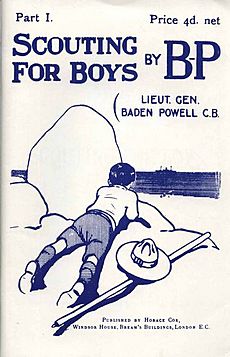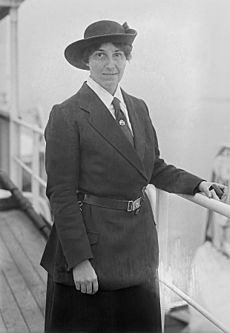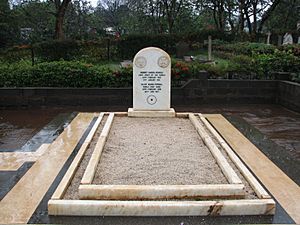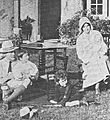Robert Baden-Powell, 1st Baron Baden-Powell facts for kids
Quick facts for kids
The Lord Baden-Powell
|
|
|---|---|
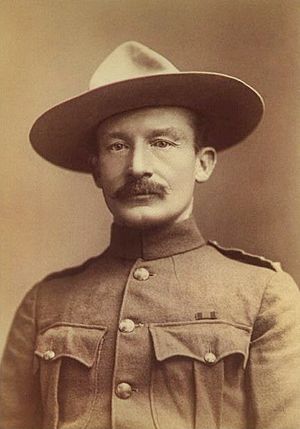
Baden-Powell in 1896
|
|
| Nickname(s) | B-P, Robin (by his wife) |
| Born | 22 February 1857 Paddington, London, England |
| Died | 8 January 1941 (aged 83) Nyeri, British Kenya |
| Buried |
St Peter's Cemetery, Nyeri, Kenya
(0°25′08″S 36°57′00″E / 0.418968°S 36.950117°E) |
| Allegiance | United Kingdom |
| Service/ |
British Army |
| Years of service | 1876–1910 |
| Rank | Lieutenant-General |
| Commands held |
|
| Battles/wars |
|
| Awards |
|
| Spouse(s) | Olave St Clair Soames |
| Children |
|
| Other work | Founder of the international Scouting Movement; writer; artist |
| Signature | |
Lieutenant-General Robert Stephenson Smyth Baden-Powell, 1st Baron Baden-Powell of Gilwell, born on February 22, 1857, and passing away on January 8, 1941, was a British Army officer and writer. He is most famous for founding the worldwide Scout Movement. With his sister Agnes, he also helped start the Girl Guide / Girl Scout Movement.
Baden-Powell wrote the first versions of Scouting for Boys, a book that greatly inspired the Scout Movement. He served in the British Army from 1876 to 1910, mostly in India and Africa. In 1899, during the Second Boer War in South Africa, he successfully defended the town of Mafeking.
Some of his military books, written for training soldiers, were also popular with boys. In August 1907, he held a special camp called the Brownsea Island Scout camp. This camp is now seen as the beginning of Scouting. He then wrote Scouting for Boys, which was published in 1908. In 1910, Baden-Powell left the army to focus on the Scout Association.
The first big gathering of Scouts, called a Scout Rally, happened in 1909. Girls who attended this event inspired Baden-Powell and his sister Agnes to create the Girl Guide and Girl Scout organization in 1910. In 1912, he married Olave St Clair Soames. He continued to guide the Scout and Girl Guide movements until he retired in 1937. Baden-Powell spent his last years in Nyeri, Kenya, where he died and was buried in 1941. His grave is now a national monument.
Contents
Robert Baden-Powell: Early Life
Robert Baden-Powell was born in London on February 22, 1857. His father, Baden Powell, was a professor at Oxford University and a priest. His mother was Henrietta Grace Smyth. When Robert was only three years old, his father passed away.
His mother, Henrietta, was a strong woman who wanted her children to do well. She changed the family name to Baden-Powell to connect her children to her late husband's well-known name. Robert often said that his mother was the main reason for his success.
He went to Rose Hill School and later received a scholarship to Charterhouse School, a famous school in England. He was very talented, playing the piano and violin, and he was good at drawing with both hands. He also loved acting. During school holidays, he went on exciting trips like yachting and canoeing with his brothers. He even learned early Scouting skills by tracking animals and cooking in the woods near his school, which was off-limits!
Military Adventures and Skills
In 1876, Baden-Powell joined the 13th Hussars in India as a lieutenant. He was very good at military scouting, which means finding out information about the enemy. He improved these skills while serving in South Africa in the 1880s, where he was praised for his work.
In 1890, he became a Major and worked as a military secretary in Malta. He also gathered information for the military in the Mediterranean Sea. He sometimes traveled disguised as a butterfly collector, secretly drawing military plans into his butterfly sketches. In 1884, he published a book called Reconnaissance and Scouting.
Baden-Powell returned to Africa in 1896. He served in the Second Matabele War, where he led missions into enemy areas. This experience was very important for him, as many of his later ideas for the Boy Scouts came from this time. Here, he met an American scout named Frederick Russell Burnham. Burnham taught Baden-Powell about the American Old West and woodcraft, which are skills like living in nature. Baden-Powell also learned about the campaign hat and the many uses of a neckerchief during this time.
After his time in Rhodesia, Baden-Powell served in the Fourth Ashanti War in Gold Coast. In 1897, at 40 years old, he became the youngest colonel in the British Army and took command of the 5th Dragoon Guards in India. He later wrote a small guide called Aids to Scouting, which was based on his lectures about military scouting and the lessons he learned from Burnham. This book was meant to help train new soldiers.
The Siege of Mafeking
Baden-Powell went back to South Africa before the Second Boer War began. He was told to keep a mobile force ready, but instead, he gathered supplies and set up a base in Mafeking. The town was then surrounded by a Boer army, sometimes with over 8,000 soldiers.
The Siege of Mafeking lasted for 217 days. Even though Baden-Powell could have left the town, he stayed. The siege became very famous, attracting attention from around the world. The town held out, partly because of clever tricks Baden-Powell used. For example, fake minefields were set up, and soldiers pretended to avoid invisible barbed wire. Baden-Powell even did some scouting himself. Once, he sent an armored train with sharpshooters into the Boer camp, surprising them.
During the siege, a group of white boys, too young to fight, formed the Mafeking Cadet Corps. They guarded, carried messages, and helped in hospitals. This allowed adult men to fight. Baden-Powell was very impressed by their bravery and how well they did their jobs. He later used them as an example in the first chapter of Scouting for Boys.
The siege ended on May 17, 1900. Baden-Powell was promoted to major-general and became a national hero in Britain.
In 1903, Baden-Powell became the Inspector-General of Cavalry. He helped improve training for British cavalry, giving them an advantage in scouting. In 1907, he was promoted to Lieutenant-General, but he was less active in the army because the Scout Movement was beginning to grow. In 1910, at 53 years old, Baden-Powell retired from the Army to dedicate himself fully to Scouting.
Starting the Scout Movement
When Baden-Powell returned from Africa in 1903, he discovered that his military training book, Aids to Scouting, was very popular. Teachers and youth groups were using it. With encouragement from his friend William Alexander Smith, Baden-Powell decided to rewrite the book for young people.
The First Scout Camp
In August 1907, he held a special camp on Brownsea Island to try out his new ideas. About twenty boys attended. Some were from local Boys' Brigade groups, and others were sons of his friends from well-known schools. This camp is now seen as the official start of Scouting.
Baden-Powell was also inspired by Ernest Thompson Seton, who founded the Woodcraft Indians in America. Seton gave Baden-Powell a copy of his book, The Birch Bark Roll of the Woodcraft Indians. The first book about the Scout Movement, Baden-Powell's Scouting for Boys, was published in parts in 1908. It has sold around 150 million copies, making it one of the best-selling books of the 20th century.
Growing Worldwide
Soon, boys and girls started forming Scout groups on their own. The Scouting Movement quickly grew, first in Britain, and then around the world. At a large gathering of Scouts at Crystal Palace in London in 1909, Baden-Powell met some of the first Girl Scouts. The Girl Guides organization was then officially formed in 1910, with Baden-Powell's sister, Agnes, helping to lead it.
In 1912, Baden-Powell began a world tour. On a ship to the Caribbean, he met Juliette Gordon Low, an American woman who had been leading a Guide Company in Scotland. Baden-Powell encouraged her to start the Girl Scouts of the USA.
In 1929, at the 3rd World Scout Jamboree, Baden-Powell received a new Rolls-Royce car and a caravan as gifts. He and his wife used them for their travels around Europe. The car was nicknamed "Jam Roll" and the caravan "Eccles." Today, both are on display at Gilwell Park, a famous Scouting center.
Under Baden-Powell's leadership, the world Scouting Movement grew very quickly. By 1922, there were over a million Scouts in 32 countries. By 1939, the number of Scouts was more than 3.3 million.
Some early Scouting badges, like the "Thanks Badges" and "Medal of Merit," had a swastika symbol on them. This symbol was used for luck in India long before it was adopted by the Nazi Party in 1920. When the Nazis started using the swastika widely, the Scouts stopped using it.
Nazi Germany banned Scouting in June 1934 because they saw it as a threat to their own youth group, the Hitler Youth. Baden-Powell's name was even included in a secret list of people to be arrested if the Nazis invaded the United Kingdom. He never knew about this list because it was only made public after his death.
At the 5th World Scout Jamboree in 1937, Baden-Powell said goodbye to public Scouting life. February 22, which is the birthday of both Robert and Olave Baden-Powell, is still celebrated as Founder's Day by Scouts and World Thinking Day by Guides. It's a day to remember and celebrate the work of the Chief Scout and Chief Guide of the World.
Later Life and Legacy
Baden-Powell passed away on January 8, 1941. His grave is in St Peter's Cemetery in Nyeri, Kenya. His gravestone has a special symbol: a circle with a dot in the center "ʘ". This is a trail sign that means "Going home" or "I have gone home." His wife, Olave, moved back to England, but after she died in 1977, her ashes were brought to Kenya and buried next to her husband. In 2001, the Kenyan government declared Baden-Powell's grave a National Monument.
In 1937, Baden-Powell received the Order of Merit, one of the highest awards in the United Kingdom. He also received 28 awards from other countries. The Bronze Wolf Award, the highest honor in world Scouting, was first given to Baden-Powell in 1935. He was also the first person to receive the Silver Buffalo Award in 1926, which is the highest award from the Boy Scouts of America.
In 1931, a mountain in California was named Mount Baden-Powell by his old Scouting friend, Frederick Russell Burnham. Today, another nearby peak is named Mount Burnham to honor their friendship. Baden-Powell was nominated for the Nobel Peace Prize many times and received the Wateler Peace Prize in 1937. In 2002, he was named 13th in the BBC's list of the 100 Greatest Britons.
In June 2020, a statue of Baden-Powell in Poole, England, was considered for removal. It was later boarded up for protection. Many local people and Scouts protested against its removal, wanting it to stay in place.
Baden-Powell's Writings and Art
Baden-Powell wrote many books and other texts during his time in the military. He did this to earn money and to help educate his soldiers. Some of his early works include:
- 1884: Reconnaissance and Scouting
- 1889: Pigsticking or Hoghunting
- 1899: Aids to Scouting for N.-C.Os and Men
Baden-Powell was known as an excellent storyteller. Throughout his life, he shared exciting stories with audiences. After Scouting for Boys was published, he continued to write more handbooks and educational materials for Scouts and their leaders. In his later years, he also wrote about the Scout movement and his ideas for its future. He spent much of his last two years in Africa, and many of his later books were about African themes.
Some of his other well-known books include:
- 1908: Scouting for Boys
- 1912: The Handbook for the Girl Guides or How Girls Can Help to Build Up the Empire (with Agnes Baden-Powell)
- 1915: My Adventures as a Spy
- 1916: The Wolf Cub's Handbook
- 1919: Aids To Scoutmastership
- 1922: Rovering to Success
- 1933: Lessons From the Varsity of Life
- 1935: Scouting Round the World
- 1939: Paddle Your Own Canoe
Baden-Powell's father and maternal grandmother were both artistic, and he himself painted or sketched almost every day. Most of his artworks were humorous or informative. His books are filled with his pen-and-ink sketches, which are often playful. He always carried a sketchpad and used it frequently for drawings and ideas for his watercolor paintings. He also created a few sculptures.
Personal Life and Family
In January 1912, while on a Scouting World Tour, Baden-Powell met Olave St Clair Soames on a ship. She was 23, and he was 55, but they shared the same birthday, February 22. They got engaged in September of that year, which caused a lot of excitement in the news because of Baden-Powell's fame. To avoid too much attention, they married privately on October 30, 1912. Scouts from all over the world each donated a penny to buy Baden-Powell a wedding gift: a motor-car.
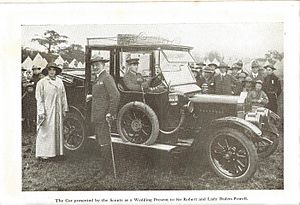
The couple lived in Pax Hill in Hampshire, England, from about 1919 to 1939. This house was a gift from Olave's father.
In 1939, they moved to a small house he had built in Nyeri, Kenya, near Mount Kenya. He named the house Paxtu. It was located on the grounds of the Outspan Hotel. Today, the Paxtu cottage is part of the Outspan Hotel and serves as a small Scouting museum.
Robert and Olave Baden-Powell had three children: Arthur Robert Peter (who later inherited his father's title), Heather Grace, and Betty St Clair. When Olave's sister passed away in 1919, Olave and Robert welcomed her three daughters into their family and raised them as their own.
Images for kids
-
Reviewing the Boy Scouts of Washington, D.C. from the portico of the White House: Baden-Powell, President Taft, British ambassador Bryce (1912)
See also
 In Spanish: Robert Baden-Powell para niños
In Spanish: Robert Baden-Powell para niños


